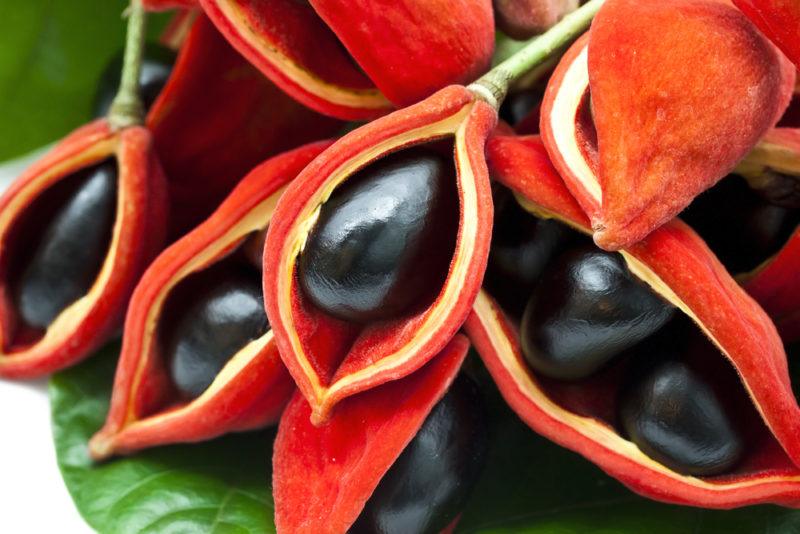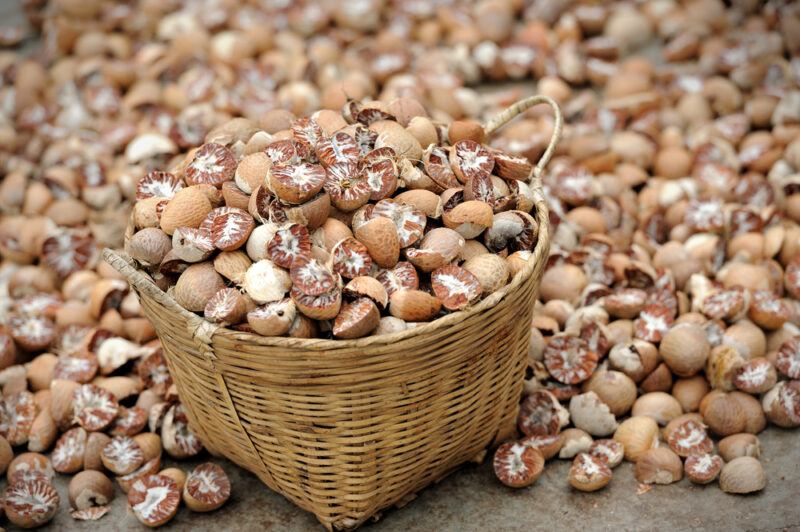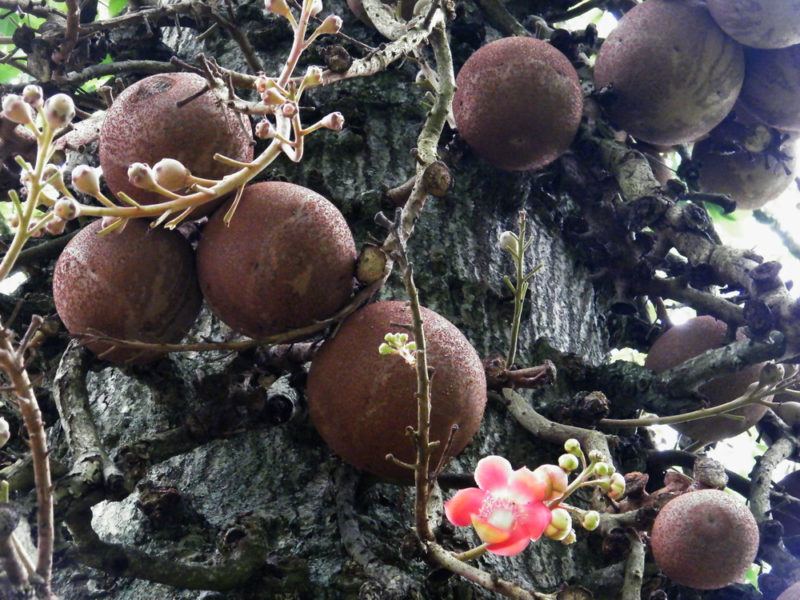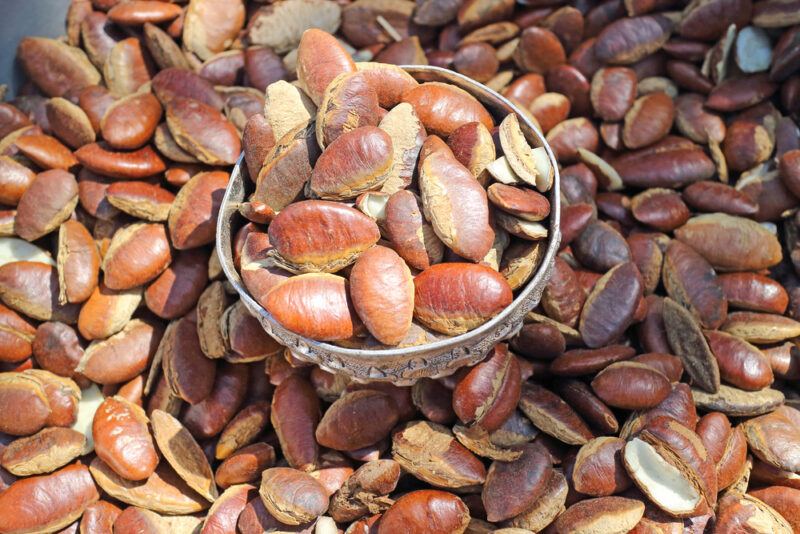
Nuts are popular ways to increase your healthy fat and protein intake. They’re easy snacks too, ones that offer plenty of nutrients. But, most conversations about nuts focus on the commonplace choices, like cashew nuts, almonds, and walnuts. Yet, there are also many exotic nuts out there that aren’t often talked about, let alone seen or eaten.
Some of these nuts are fairly easy to find, while others might a bit more searching. Thankfully, online shopping gives you access to a broad marketplace and you’ll be able to find some of the nuts that way. Others might only be available if you’re in the right part of the world and are willing to forage them for yourself.
Before we dive into the list, we should mention that the term nut is somewhat confusing. Some foods that we call nuts are not a nut in the botanical sense (like peanuts, which are actually legumes instead), even though they have a similar taste and texture to actual nuts.
For this list, we’re including anything that is generally called a nut, regardless of the food’s botanical classification. In many cases, the term is based on the flavor, texture, and nutrient composition of the food.
And, if this list has piqued your interest, you might also enjoy our lists of exotic fruits, wild mushrooms, and weird colored foods.
Exotic And Weird Nuts (With Pictures)
Black Walnuts

The walnuts you normally see in the grocery stores are considered an English walnut. Black walnuts are a different variation, they tend to have tougher shells. Their flavor is much bolder too. This flavor may be one reason why black walnuts are not as popular as English walnuts. Still, some people do enjoy the distinctive flavor, so don’t write the nuts off just yet.
Black walnuts do have an advantage anyway. They can grow in many parts of the Eastern United States, while English walnuts have a more limited range. While the nuts aren’t commercially produced like regular walnuts, almonds, or other types of nuts, many people harvest wild black walnuts throughout the United States.
Kurrajong

The kurrajong tree (Brachychiton populenus) is a native Australian tree that produces distinct orange seed pods. These pods tend to be orange or red when ripe and contain eight black seeds.
The species is also sometimes called a peanut tree, as the seeds can be eaten raw and taste like peanuts. While these are botanically considered to be seeds, rather than nuts, they do have a similar nutritional profile and texture to botanical nuts. And, as we mentioned before, many of the nuts that we eat aren’t technically nuts at all.
Breadnut

The breadnut goes by a few different names, including maya nut and ramon. It is native to Papa New Guinea, the Philippines, and possibly the Moluccas in Indonesia, and is grown in those areas along with surrounding regions.
The seeds are a little similar to chestnuts. They can be roasted, steamed, or boiled, but don’t tend to be eaten raw. Because of this, breadnuts are sometimes called a pseudocereal too.
There’s an important distinction to make here. Breadfruit is considered a seedless version of the plant called either Artocarpus altilis or Artocarpus communis, while breadnut may be a different species entirely. Even if the two turn out to be the same species, breadfruit trees are seedless, so you won’t find breadfruit and breadnuts on the same tree.
Palm Nuts

Palm trees are an extensive plant family and there are more than 2,000 different species currently known. They tend to grow in tropical and subtropical regions, and have been highly cultivated.
The term palm nut collectively refers to the fruit and seeds of any of the palm species, although there is much variation between these. Coconuts are, of course, the most famous example, although coconuts aren’t eaten as a nut. Some more traditional nuts from palms include coquilla nut, doum nut, and nuts from the African oil palm.
While not every palm species has edible nuts, many do. This highlights just how many types of edible nuts there are out there to choose from.
Candlenut

The candlenut tree grows in many parts of the world, to the point that we know little about its native habitat. However, the tree has become famous in Hawaii and is a symbol of peace and enlightenment.
Unlike many other nuts, candlenuts are toxic when they are raw. They should always be cooked first, as the cooking process destroys the toxic alkaloids.
The nuts are often cut into slivers before cooking. These slivers end up having a delicious nutty flavor. The nuts can also be ground and used to thicken some meals.
Gabon Nut

The gabon nut sometimes goes by the name African walnut, even though it is not related to the walnut at all. The nuts are so named due to their visual similarity to walnuts. Roughly half of the nut is fat and most of this is oleic acid, which is the same healthy fat found in olive oil.
The nut has a mild flavor, making it an easy one to enjoy. While the nut can be eaten raw, boiling, roasting, or even fermenting are all options as well. As with many other nuts, it can be made into flour too.
Water Caltrop

Water caltrop nuts are sometimes known as water chestnuts or bat nuts (it’s easy to see where the bat nut name came from). The plant is unusual, as water caltrops are a type of floating aquatic plant. Three distinct species are known as water caltrop and they all produce similar fruit.
Each of the bat-shaped or bull-shaped fruits contains a single large seed. The seed is rich in starch and carbohydrates, while also offering many nutrients. It can even be used as a staple food instead of rice or similar ingredients.
The nuts are mostly served steamed. They’re popular accompaniments to stir fries and braised dishes, due to their texture and nutrient content.
Chinese Chestnuts

Chinese chestnut trees are becoming increasingly popular throughout the United States as a tree that gardeners can grow at home. The appearance of the tree is one reason, as a Chinese chestnut tree complements many gardens well.
The nuts are also popular. These tend to be high in nutrition and low in fat. The nuts grow in burs that fall from the tree once they are ripe. This makes the nuts easy to harvest. Also, the nuts can be eaten raw, so there is no roasting to worry about.
Malabar Chestnut

Malabar chestnuts tend to be light brown with white striping, making them interesting right from the beginning. When eaten raw, the chestnuts have a similar flavor to peanuts. These nuts can be used cooked as well or ground to produce a type of flour. There are even cases where people grind the chestnuts to create a hot drink.
The seeds are the main reason that the species is grown, although other aspects to the tree have medicinal uses. For example, the bark may be used to treat headaches.
This isn’t a species that you’ll often find in the United States. Instead, it is native to some parts of Mexico, Peru, and Brazil. However, the plant is sometimes sold for ornamental purposes throughout the world.
Kola Nut

Kola nuts come from two species of kola trees (Cola nitida and Cola acuminata). Both trees belong to the cocoa family and they’re native to the tropical parts of Africa.
The nuts are enjoyed by people throughout West Africa, regardless of their social strata or job. Not surprisingly, kola nuts have also ended up being a significant cultural symbol, one that is strongly associated with West Africa.
Kola nuts, like many others, have also been linked to health benefits. These benefits are often exaggerated, as tends to be the case for many healthy foods, but the kola nut does have some interesting qualities. In particular, the nut contains stimulant compounds, including caffeine, theobromine, and glucose.
With this combination, it’s no wonder that the nut is often linked to increased energy and less fatigue. And, of course, these same nuts are used in cola soda that is enjoyed throughout the world.
Chilean Hazel

This nut comes from the species Gevuina avellana and, not surprisingly, is native to south Chile. The name of the species and the term Chilean hazel are both references to European hazelnuts, even though the species is not closely related to the European hazelnut.
The fruit from the tree starts out red and then turns black as it matures. The seeds within these fruits are sometimes eaten raw. They can also be toasted or boiled in water.
Almost 50% of the nut consists of oil and there is only around 12% protein. The oil content makes the nut useful in various industries. For example, the oil is used in some cosmetic products and sunscreen.
Mongongo

The mongongo tree is another species that is often found in Africa. This time, it is most common in the subtropical regions of southern Africa. The species is an interesting one, as the leaves are shaped somewhat like a hand and the wood is pale yellow.
While the nuts have become a staple part of the diet in some areas, some work is required to extract them. The dried fruits are first steamed, which helps to soften their skin. The fruits are then peeled and cooked, which allows the flesh of the fruit to separate from the nuts.
An easier, although less appealing, approach is to gather nuts from elephant dung. This works well because the nuts survive digestion, while the surrounding fruit does not.
Acorns

Acorns might not be an unusual nut, but we often don’t think of them as something to eat. In fact, raw acorns can be high in tannins. These tannins don’t just make the acorns taste bitter, they can also be toxic. This means that you’ll mostly need to process the acorns a little before you can eat them.
Leaching is a common technique. You can do this by heating the acorns in boiling water and regularly changing the water until you end up with clear water. Leaving the acorns to soak in a bath of baking soda infused water can also be effective, although you’ll need to leave them soaking for 12 hours or more.
Once they have been leached, acorns can sometimes be enjoyed as-is or used in various recipes. Some people go as far as to create flour from acorns.
Your outcomes will strongly depend on the type of acorn that you’re using. Some of them are ‘sweet’ and have relatively few tannins, while others are much more bitter. The fat, protein, and carb content can also vary dramatically from one species to another. Some acorns end up being mostly carbs, while others contain a decent amount of fat too.
Canarium Nut

The word canarium refers to an entire genus of trees, which contains 100 or so species, including the tree that produces the pili nut. The nut called canarium nut tends to come from the species Canarium harveyi and Canarium indicum. The second of these species, Canarium indicum, is an important tree in the Southwest Pacifiic and eastern Indonesia because of these nuts.
Canarium nuts are oily nuts that can be eaten as-is, roasted, or smoked. Once again, the nuts can also be used in cooked meals, either whole or after being ground.
While the nuts themselves are safe and healthy, it is important to avoid eating the seed coat. Compounds in this seed coat can lead to diarrhea.
American Beechnut

The beech tree produces triangular fruits in prickly husks. Once the husk has been peeled off, the beechnut can then be eaten as-is. Some people choose to roast them first and you could even make a pie using the nuts as an ingredient.
These nuts are a good choice for foragers, as American beech trees are easy to identify and can be found in many forests across the country.
Jack Nuts

Jack nuts are the seeds found in ripe jackfruit. They’re easily overlooked by people who rely on the fruit, but the seeds are appealing in their own right. When eaten raw, the nuts have a similar flavor to Brazil nuts, while roasted jack nuts end up being similar to chestnuts in flavor.
The nuts are sometimes used as an ingredient in curry or in dessert. While the nuts have not been widely consumed, there has been increasing interest in them due to growing popularity for jackfruit itself.
There are some health advantages too, as jack nuts have a good balance of nutrients. They’re particularly rich in riboflavin and thiamin, both of which have been linked to skin health and even energy.
Betel

The betel nut also goes by the name areca nut and it is a famous type of palm nut. It is often wrapped in betel leaves, although those leaves come from an entirely different species.
While the nut continues to be popular and is often chewed, it has been linked to a variety of health problems. Indeed, chewing on the nut may increase the risk of cancer in the esophagus or the mouth. As such, this is one of the only nuts on this list that you shouldn’t consider eating yourself.
Red Bopple Nut

This nut comes from the species Hicksbeachia pinnatifolia, which is an Australian species. It goes by various names, including monkey nut, red nut, and ivory silky oak.
The fruits of the tree are red and fleshy, and the seeds are contained inside of these. While the species is related to macadamia, the nuts that it contains aren’t nearly as popular. Indeed, the tree is rarely grown commercially and is not easy to include in a garden.
The nut needs to be eaten or processed while it is still fresh, as it quickly deteriorates once it is out its shell.
Pili Nuts

Pili nuts have an unusual triangular or teardrop like shape. It is one of the few nuts on this list that you can actually buy commercially, as a company called Pili Hunters harvests these and sells them as a keto super nut.
The nut’s magnesium content is one of its most notable features. It contains more magnesium than most, if not all, other types of nuts. It is high in copper and manganese too, which are both important compounds for health.
The nuts do tend to be expensive, largely because they are harvested in the wild, rather than being commercially grown. However, their nutritional profile and rich buttery flavor do make them popular.
Paradise Nut

Paradise nuts have a similar flavor to Brazil nuts and come from the same family. Another similarity is that the fruit from both trees is a woody capsule that has a detachable lid. This type of fruit is sometimes known as a monkey pot, named after the way that monkeys get nuts from the fruit.
While paradise nuts can be enjoyed raw, some caution is needed. The nuts can absorb heavy metals from the soil, especially selenium. These heavy metals could be damaging to health, especially if you’re eating large quantities of the nuts.
Ginkgo Nuts

You may have heard of ginkgo nuts before, as they’re common in Asian cooking and can increasingly be found in the United States. The nuts are interesting, as they are highly nutritious and taste good too.
They can also be a little difficult to harvest, as the fruit that surrounds the nuts can cause allergic reactions. Ginkgo fruit smells pretty horrible too.
Then, if all of that weren’t enough, there’s the fact that raw ginkgo nuts are toxic. They need to be cooked before you can eat them. Thankfully, roasting the nuts is easy and you can do this at home without investing too much time or energy into the process.
Monkey Puzzle Nut

The tree Araucaria araucana commonly goes by the name monkey puzzle tree. The name is thought to come from an observation, when the tree was relatively unknown, where one observer mentioned that it would puzzle a monkey to climb the tree.
The tree produces long cones. These are male or female, with the male cones mostly being produced on different trees to the female ones. The female cones contain around 200 seeds and break down once they hit maturity, which then releases the seeds.
The seeds, or nuts, are large and have a similar shape to pine nuts. When cooked, the seeds tend to have a slight sweet flavor. These can be eaten raw too, although the flavor of the cooked nuts is generally preferred. They need to be cooked or eaten not long after they are released, as their starch content is high, so the seeds will quickly go off.
Finally, the high starch content means that you shouldn’t dry roast the nut. Doing so will make it very tough and almost impossible to eat. Simmering the nuts in water for around 10 minutes is much more effective.
Bunya Nut

The bunya pine tree is closely related to the monkey puzzle tree. Most of the same principles even apply to the nuts of both trees.
A key difference is that bunya nuts are much larger than monkey puzzle nuts. Bunya nuts are an impressive 15 grams each, while the cones from the tree can weigh around 10 kilograms. This makes them around three times the size of monkey puzzle nuts (and monkey puzzle nuts aren’t tiny anyway).
Oysternut
Oysternuts come from the species Telfairia pedata and you’ve probably never seen them before. The flat seeds are native to Tanzania and are generally harvested when the fruit drops from the vine.
Like many nuts, these can be consumed fresh, but they can also be dried, crushed, and turned into a paste. The paste has a role in a variety of meals, providing an interesting sweet flavor.
The nut has an interesting flavor, which includes some notes that are similar to green beans and are also a little like green almonds. While this doesn’t sound amazing, the nuts are popular and many people love the way they taste.
There’s a catch though – these nuts are native to Uganda and Tanzania. They’re not often found outside these areas, so you might be out of luck if you live elsewhere.
Tapos Tree

Then there’s the tapos tree. This species is normally grown for ornamental reasons and often reaches less than 50 meters in height.
The nuts are a deep brown, with a color that’s reminiscent of chestnuts. These split open to reveal a white interior, but the nuts aren’t safe to eat raw at all. They need to be cooked to make them viable for eating.
Of course, eating the nuts isn’t the only use of this tree. The fruits can also be used to create oil and resin, while the leaves of the tree are relevant for malaria treatment.
Argan Nuts

Most conversations about argan focus on argan oil, which is created by extracting and processing the nuts. If the argan oil is going to be used for culinary purposes, it’s often roasted and then pressed. But, if the focus is on a cosmetic use, then it’s generally just pressed instead.
Argan oil is so popular that it’s hard to find argan nuts on their own. They’re not as appealing as the oil anyway, as argan nuts remain bitter even after they’ve been roasted.
Dika Nuts

Dika nuts actually come from the African mango and have a variety of uses. They’re often used just like regular nuts, which includes eating them raw or roasting the.
The nuts are also commonly used in supplements, particularly those for weight loss. Evidence of any weight loss benefits is limited, but that doesn’t stop companies from relying on the nuts regularly.
Despite the name African mango, these nuts aren’t related to actual mangos at all. The fruit has a variety of uses as well. This includes eating it fresh or creating preserves from it.
Coco De Mer

Coco de mer is a rare plant – rare enough that it is considered engaged and has been illegal to poach since 1995. The seeds are also incredibly distinctive. For one thing, they’re larger and heavier than any other known nut. The shape also looks somewhat like a pair of buttocks from one side, which certainly creates a talking point.
The rarity and shape of coco de mer nuts have led to no shortage of legends surrounding the fruit. There is even talk of potential healing properties. Oddly, there’s still much unknown about the trees, including how they are pollinated, which adds to the air of mystery.
Butternut

The name butternut makes it sound like we’re talking about butternut squash, but this isn’t the case at all. We’re talking about butternuts themselves, which are also called white walnuts.
As that name suggests, these are indeed a type of walnut. They’re found in some parts of the United States and Canada, and offer a slight buttery flavor with the familiar nuances found in regular walnuts. Basically, if you enjoy regular walnuts, you’re likely to enjoy these as well.










 The Best Tequila for Shots And Best Tequila Chasers
The Best Tequila for Shots And Best Tequila Chasers
But how about our rare and beautiful oysternut from East Africa?
Interesting! Haven’t heard of that one. They sound delicious!
Telfairia pedata is their botanical name. They aid in healing after child birth, help flow of breastmilk, improve fertility. High in fat, moderate in protein, low in starch, the have a shelf life of up to 8 years!!!
why acorn… hmm….
The picture of the black walnuts is right but the nut meats laying next to the nuts are English walnuts. Black walnuts have a darker skin.
Thank you for this article!
It seems with so many (Apparently over 900) types of nuts, more of the exotic types should be incorporated into our diets
Any idea of where to purchase the exotic nuts?
Preferably a blend / mix?
thank you!
What about deez nuts?
The most exotic of nuts. 😂
And very flavourful too!!
Water chestnut (菱) flour (菱粉) is sometimes marketed in English as Tapioca Flour and can be used somewhat interchangeably although one may be a bit starchier than the other.